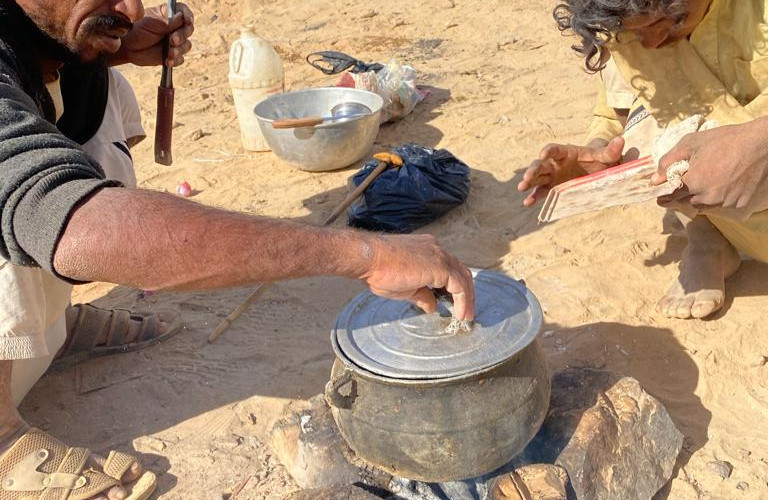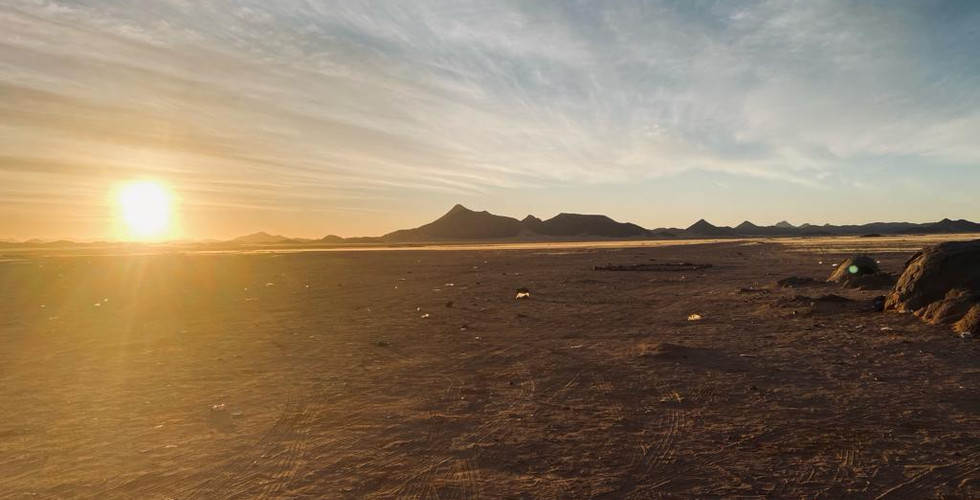Second testimony of Mohammed Jamal Ajabna, February 2024, Cairo, Egypt.
I have already narrated how my family and I had moved from Khartoum to Kosti, White Nile State. We stayed there for an unanticipated 5 months given that the situation in Khartoum remained violent. Our life in Kosti was challenging since we were a large family: grandmother, mother, maternal aunts, maternal uncle, and cousins. We made up a group of 15 including myself. The situation was complicated by the fact that we had no support system in Kosti in the beginning and no source of livelihood.
Everyday expenditures were exacerbated by expensive rental rates, costs of food, and necessary medication. Over time we settled well within Kosti. It was a welcoming and safe city for quite a long time. Things quickly changed when the Sudanese Armed Forces withdrew from Wad Medani, Gezira State in December 2023. The city which had replaced Khartoum in terms of essential services was suddenly overwhelmed by Rapid Support Forces troops.
The RSF came to control the whole strategically positioned Gezira State. Wad Medani lies at the centre of Sudan and connects the East of the country to the West. It is a hub for economic activity and the movement of goods. This incident was to affect other states in Sudan since it triggered another mass movement of people who fled the city due to fear for their lives. People who had been displaced within Gezira found themselves having to move yet again. Ultimately, this instability affected Kosti which was increasingly surrounded by multiple locations which had been taken over by the RSF. Examples are Wad Ashana south of Kosti. Essential goods were no longer arriving on a regular basis, and the area was characterised by intense security measures adopted by the Sudanese Armed Forces, the police, and the General intelligence agency .
The city of Kosti was becoming heavily militarised. Ordinary citizens were enjoined to take up arms. Many were reluctant to do so because they were in dread of what the RSF could do. This was due to the reputation it had for extreme violence and destruction. The whole of Sudan had seen the demolition of citizens' possessions in Medani very recently and it seemed to present a pattern which had started in Khartoum. It seemed that those who had moved from Khartoum especially were unwilling to witness the excesses of war for the third time. In a matter of days, the city of Kosti was being vacated; people fled, and merchants liquidated their assets at the basest of prices.
Although we assumed that national and international humanitarian actors would stay to provide aid and services to the already present multitudes of internally displaced persons they left too quickly. These organisations evacuated their permanent staff and equipment across the border to Renk in Northern South Sudan. IDPs were left to face an uncertain future in Kosti. The city was abandoned in the space of a few weeks.
The city which had been fully functioning just two weeks before became silent. Markets and hospitals shut down. There was no fuel, no electricity supply, or telecommunications channels. This rapidly deteriorating infrastructure forced us to take the decision - like many others - to leave. We decided that it was time to leave Sudan and head to Egypt. The quickest and most risky route was through smuggling since the regulations for state-approved entry had become very difficult and the wait for visas could extend to six months. We would have to go to the Atbara River Nile State to meet the smugglers and move from there.
The trip from Kosti to Atbara by bus would have cost 250 SDG ( calculated as 250 000 due to inflation) the equivalent of 250 USD) per individual. This hike in prices was entirely driven by the war since under normal circumstances such a ticket would only cost 10 pounds ( 10 000 sdg - 10 USD). Since we were numerous we decided to cut costs we decided to use my uncle's private van to get to Atbara and eventually sell it there in order to have funds for the road ahead. My uncle and I bought fuel at black market rates - 40, 000 ie 40 SDG / 40 dollars per gallon.
On the 26th of December, we started our trip moving towards Sennar located on the Blue Nile- Sennar state. We had no idea what we would confront on the road and no information about the security situation but this was a risk we had to take since it was the only possible route out of White Nile State ( which we feared might be attacked at any time). If the route to Sennar were to be blocked we would be trapped so we had to move quickly. We were lucky and managed to get to Sennar on the same day we left and we continued on to Sinja and Dinder both within Sennar State on the Blue Nile. From Dinder we planned to go to Geddaraf ( Gedarref State ) in Eastern Sudan. This meant we had to take a rough dirt road for 6 hours since the asphalt road ( via Medani ) was now entirely controlled by the RSF. We did not want to encounter them and were hence willing to take a more arduous, exhausting journey.
On our six-hour trip on this rough road, we saw villages. We were thrilled and touched by the hospitality we were offered in these humble places. One notable example was Wad Haleema village where travellers were offered free rudimentary medical care and food. People were gracefully sharing their own meagre resources and had been doing so since the time the RSF had dominated the area surrounding the safer route. We got to Gadaref on the night of the 26th at 11 pm. We spent the night there with resident relatives. We had planned to leave the next morning in order to get to Atbara as quickly as possible, but the fatigue of the journey had at this stage caught up with us.
We stayed for the day, before our day had started we were visited at the home of our relatives by the military intelligence connected to SAF. They had noted the presence of newcomers within the city of Gedarif and they undertook the necessary security procedures: we were interrogated and searched thoroughly ( 2 hours) but these measures were not aggressive or hostile. I noticed at the time that this was the most rigorous military check I had witnessed throughout my movements during this whole war ( I had moved within Khartoum from Deim to Kalakla in South Khartoum to Jebel Awlia South Khartoum suburbs to Kosti White Nile and finally this trip I describe in this post ). In this present context, I noticed that groups of SAF soldiers were present every 2 kilometres. On the 28th of December, we headed towards Kassala ( Eastern Sudan), this trip was more straightforward and we arrived within 6 hours only because the checkpoints were extensive. Again, villagers along the way continued to offer their generous support to travelers.

Kassala, Eastern Sudan, Picture Copyright Mohammed Jamal Ajabna.
From Khashm Al-Girba ( Kassala state, Eastern Sudan ) we could see that the local population was increasingly armed with small guns as well as heavy artillery. This was a measure of self-defense and did not prevent the offer of hospitality that we had seen throughout the trip. While I was having coffee some of the armed locals told me that they were prepared to battle the RSF and its recruited mercenaries who were recruited from West Africa but even more importantly they were willing to fight the army of the mastermind behind the destruction of Sudan and they were clear that the culprit was the UAE. I was struck by this accusation at the time and I will never forget the initial impact it had on me. I was struck by the contradictions of the situation I was witnessing: people carrying food and medicine to help travelers while simultaneously bearing M16s and AK-47s. I watched pick-up trucks carrying life-saving supplies as well as huge machine guns and RPGs. As travelers, we felt safer since we knew we were in hostile surroundings in a desert setting. We finally arrived at Kassala ( Kasala State) on the same evening.
Khashm Al-Girba (Kassala state, Eastern Sudan), Pictures Copyright Mohammed Jamal Ajabna- click the right arrow in the picture to view the pictures.
Kassala like Gedaref before it was heavily occupied by SAF and the GIA, it was equally densely populated by the recent arrival of IDPs who had sought refuge there after the fall of Medani to the RSF. We stayed for a day and quickly on the 30th of December started a tedious journey, which lasted 14 hours, to Atbara. We arrived on the same day at night and stayed with friends who we had made on the trip from Kosti. Their friends were originally from the outskirts of Atbara and they did not hesitate to host us in their home in Al Bekheitab. It was a simple place with no electricity or telecommunications networks but it was safe. The area was rural and beautiful with huge homesteads and farms in proximity to the River Atbara. It was the ideal place for us both for psychological and financial reasons. We saved 100 USD per night since that was what we would have paid had we opted to stay within the city itself. We were aware that in order to arrange for our travel to Egypt we would have needed to stay in Atbara for at least 10 days. At any rate, these friends were adamant that we would not go anywhere and they did not want us to waste our already limited financial resources.
Al-Bekheitab, Atbara. The river in the pictures is the Atbara River. Pictures Copyright Mohammed Jamal Ajabna- click the right arrow in the picture to view the pictures.
We planned to leave on the 9th of January and we found a smuggler who was willing to take us as a family of 14 members on a truck for 3500 USD ( that was the best offer at the time). In general, these trucks had a holding capacity of 18 to 20 individuals for that price but I preferred to make up the difference and not allow any people to come with us. This was because my aunt was a stroke patient** and my grandmother had recently been unwell. I wanted to provide a modicum of comfort for them even though this was not to be the case. Even though we had space on the truck the trip was still very difficult. We left in the afternoon of the 9th after our contact came to get us, we went to a location called Seedorne an hour East of Atbara. This was a local market and trading port run by members of the Rashaida ethnic group. In this place, pick-up tricks were prepared and loaded for journeys to Egypt. We were introduced to our driver who ended up being a friendly man. We bought supplies and water and eventually left at 10 pm.
Where we spent our first night. Pictures Copyright Mohammed Jamal Ajabna- click the right arrow in the picture to view the pictures.
When we started this leg of the journey we did not know what to expect. We were driving through the desert for 6 hours and we only stopped for one hour to rest at 5 am the next morning near some hills. We traveled for another hour before we stopped for breakfast in another location called Gandoora ( a mining and smuggling site). Finally, we set off again at 8 am but I had no clue about the direction we were taking, all I could see were mountainous and hilly outcrops surrounded by sand. After 6 hours we stopped at another Rashaida local market called the first Takhzeenah ( meaning storage spot). This location was secret and only known to the smugglers. We did not want to eat the food offered at a cost: desert lizards and rice, so we settled for the cakes we had brought with us. The driver and his assistant had their meal and we set off at 3 pm through the same mountains and valleys for another 5 hours.
Gandoora. Pictures Copyright Mohammed Jamal Ajabna- click the right arrow in the picture to view the pictures.
The first Takhzeenah. Pictures Copyright Mohammed Jamal Ajabna- click the right arrow in the picture to view the pictures.
We reached the last Takhzeenah ( the last storage spot ) located on the border between Sudan and Egypt. This was yet again another market trading location used by members of the Rashaida to exchange vehicles and trade in all forms of foreign currency. We were stuck in this location for two whole days due to clashes between some Rashaida and the Egyptian army. The latter had shot and killed some weapon smugglers from the Rashaida and they had retaliated so we could hear the exchange of fire as we waited. Our driver reassured us and said such incidents were common and that we should not worry since they had " eyes " who surveilled the border and relayed when it was the appropriate time for crossings to take place.
The second (last) Takhzeenah. The tents in the pictures served as home. Pictures Copyright Mohammed Jamal Ajabna- click the right arrow in the picture to view the pictures.
The wait was uncomfortable since we had by this time run out of food and water. A 16-gallon bottle of water stood at 50,000 SDG ( 50 USD). A gorassa ( local thick flour fried paste) cost 3000 SDG and a tent was 20,000 SDG ( 20 USD) a night. After two extremely difficult days, we were lucky that the border finally cleared and our friendly driver handed us over to his friend who was on the Egyptian side of the border to come for us. This new driver took us across the border but before he did so he tied us up with three ropes into the pickup to make sure that nobody flew off the truck. He was driving extremely fast and within two hours we were well a crowd the border.

On the way to Mahaliyah. Picture Copyright Mohammed Jamal Ajabna
Mahaliyah. Pictures Copyright Mohammed Jamal Ajabna- click the right arrow in the picture to view the pictures.
We reached a place called al Mahaliyah, another market within a valley that was run by Egyptian outlaws ( matareed). Here the exchange was fuel for gold provided by Rashaida. In addition, smuggling people was part of a lucrative business. Here we parted ways with our second Sudanese driver and Egyptians took over. The third driver was indeed Egyptian. He told us we would only stop to sleep after a drive of 200 km since the area was very dangerous. This was what happened, and we moved again for another 9 hours after getting some sleep. We reached our final destination called Al-Kassara ( 120 km away from Aswan). Here our driver rented a mini bus to take us to Aswan. The minibus driver offered us a place to stay in Aswan for 14,000 Egyptian pounds a night. Although this was expensive we had no choice but to pay since we could have well been abandoned in the middle of the desert if we had not complied.
First picture: The road to Al-Kassara. Second: Al-Kassara. Pictures Copyright Mohammed Jamal Ajabna- click the right arrow in the picture to view the pictures.
After an exhausting trip, we reached a flat in Aswan in an hour and a half. The mini-bus driver stayed with us serving as a guide: he bought us Egyptian sim cards, exchanged money for us, and bought us our bus tickets for Cairo since we could not do any of this because we were in Egypt " illegally " so far. The next morning he took us to the bus station where he paid 550 Egyptian pounds per ticket. We finally managed to relax and eat a proper meal before leaving for Cairo at 4 pm. On the bus, the driver explained very clearly that we needed to pay him a further 50 pounds per person since he would need to pay the police at various checkpoints between Aswan and Cairo. He made the point that he was offering a service since none of us had a visa allowing us legitimate entry into Egypt. To avoid being stopped we paid and we entered Cairo " safely" the next morning.

Aswan. In Aswan, these are local houses specifically rented out to smuggled Sudanese crossing the border with no official permits to enter Egypt. Picture Copyright Mohammed Jamal Ajabna.
**Mohammed's aunt sadly passed away after they reached Cairo, Egypt. The Sudanese Embassy remained neutral and facilitated documents and burial charging institutional fees.
*This is an original piece written exclusively for PeaceofSudan.Space and has not been published elsewhere.



































































































